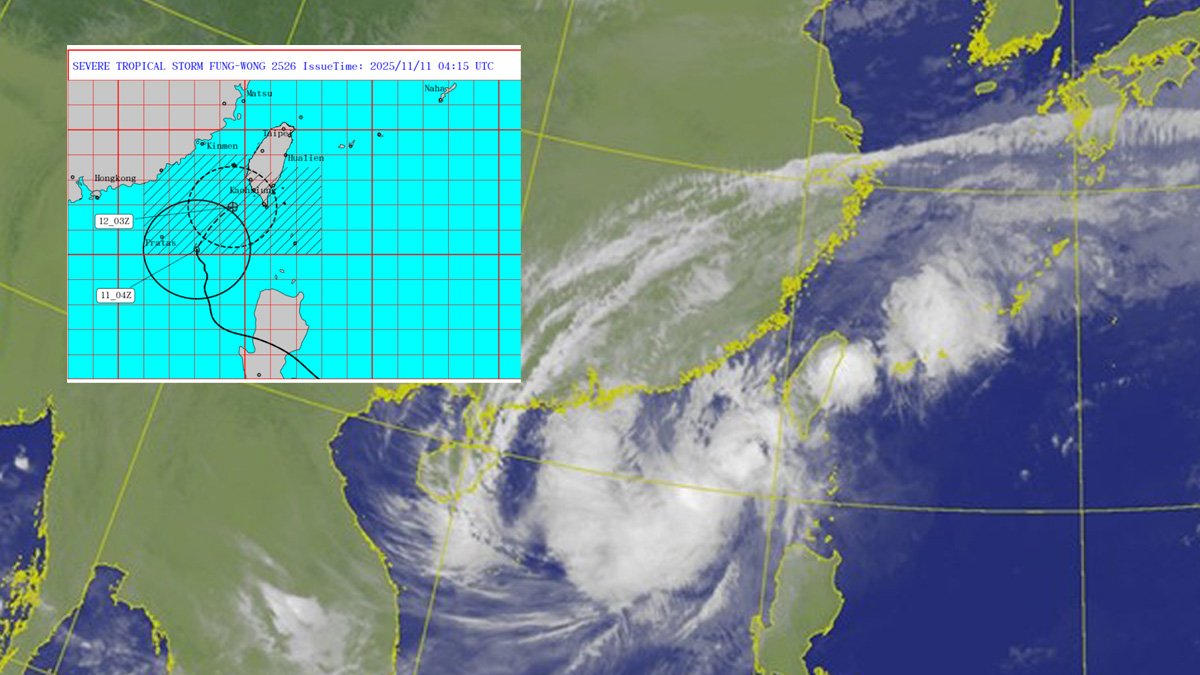Over 3,000 evacuated in Taiwan as tropical storm Fung-wong makes landfall
Tropical Storm Fung-wong made landfall between Kaohsiung and Pingtung, triggering evacuations, school closures, and major transport disruptions across Taiwan. The storm previously devastated the Philippines, leaving at least 25 dead and over 1.4 million displaced.

- More than 3,000 people were evacuated in Taiwan before Tropical Storm Fung-wong's landfall.
- Fung-wong killed at least 25 people and displaced over 1.4 million in the Philippines.
- Major disruptions hit transport services in Taiwan, with widespread flight and ferry cancellations.
Taiwanese authorities evacuated more than 3,000 residents on 11 November ahead of Tropical Storm Fung-wong’s landfall along the country’s south-western coast.
According to the Central Weather Administration (CWA), the storm was downgraded from a typhoon to a tropical storm yesterday morning. Nonetheless, the agency issued a land warning covering Tainan, Kaohsiung, Pingtung, Taitung, and the Hengchun Peninsula, citing heavy rain and strong winds.
Fung-wong made landfall between Kaohsiung and Pingtung County in the evening and is expected to exit via Taitung County early on 12 November.
By 9pm on 11 November, the storm was centred 260km west-southwest of Oluanpi, moving northeast at 23kph. Maximum wind speeds reached 90kph, with a storm radius of 200km.
As a precaution, several counties declared a typhoon day, cancelling work and classes. These included Taichung, Tainan, Kaohsiung, Yilan, Miaoli, Changhua, Yunlin, Pingtung, and Penghu, as well as Chiayi city and county.
Meanwhile, Taipei, New Taipei City, Taoyuan, Keelung, and Hsinchu, along with parts of Hualien County, continued with regular working hours.
CWA forecaster Chu Mei-lin stated that while the storm would bring particularly heavy rain to northern and eastern Taiwan, central and southern regions would also experience sudden bouts of intense rainfall.
As of 1pm on 11 November, the highest recorded rainfall was 72.4cm in Dongao, Yilan County; 40cm in Nioutou Hill, Taitung County; and 36cm in Dacukeng, New Taipei City.
Wind speeds in Taichung, Kaohsiung, and counties including Changhua, Yunlin, Pingtung, Penghu, and Lienchiang reached level 9 on the Beaufort scale, compounded by the northeast monsoon.
In Hualien County, Fung-wong caused severe flooding, destroying a makeshift passage on the Mataian River. The river overflowed and inundated a stretch of Provincial Highway No. 9 near the 231km mark, prompting road closures for inspection by the Highway Bureau.
Taiwan Railway Corp announced the suspension of operations on its Shenao and Pingsi branch lines, as well as the section between Fonglin and Rueisuei in Hualien. The shuttle bus service between the two townships was also cancelled.
Ninety-nine ferry services were cancelled by the Maritime and Port Bureau. These included routes between Matsu and Keelung, Donggang and Siaoliouciou Island, Fugang Harbor and Green Island, and the “small three links” routes from Matsu and Kinmen.
Domestic flights to Taiwan’s east coast and outlying islands were grounded after 5pm on 11 November, with cancellations also affecting international services.
China Airlines cancelled multiple services from Kaohsiung and Taoyuan to Japan, Bangkok, Hong Kong, and Chongqing. Some arrivals, including from Manila, Osaka, and Seoul, were delayed.
EVA Airways confirmed that services from Taipei would proceed, but most flights from Kaohsiung were cancelled except for a few, including routes to Narita, Osaka, and Hong Kong. A return flight from Narita was scheduled to depart at 5pm.
Tigerair Taiwan also cancelled several international round-trip flights from Kaohsiung, including those to Da Nang, Naha, Okayama, Sendai, Osaka, and Narita. Some departures were rescheduled or delayed.
The Ministry of Transportation and Communications advised travellers to confirm their schedules directly with airlines.
Prior to hitting Taiwan, Fung-wong caused severe devastation in the Philippines. The storm made landfall as a super typhoon on 9 November on the country’s north-eastern coast, with sustained winds of 185kph and gusts reaching 230kph.
According to Philippine authorities, at least 25 people were killed, and more than 1.4 million displaced due to flash floods, landslides, and storm-related incidents. Most of the fatalities occurred in the mountainous provinces of Nueva Vizcaya and Kalinga, where multiple landslides buried homes.
Among the victims were three children buried in separate incidents and two villagers killed in Kalinga. The disaster also left 29 people injured.
In anticipation of the storm’s impact, over 3,300 people were evacuated near the eastern township of Guangfu, Taiwan, where a typhoon in September had previously caused deadly flooding due to an overflowing barrier lake.
Meanwhile, in China, authorities issued an emergency typhoon response for the southeastern provinces of Fujian, Guangdong, Zhejiang, and Hainan, preparing for potential impacts from the system’s remnants.
Despite weakening to a tropical depression after landfall in Taiwan, authorities have stressed continued vigilance due to the lingering threat of sudden downpours and dangerous winds.
Kaohsiung Mayor Chen Chi-mai warned that “Fung-wong may have been downgraded to a weak typhoon but we still cannot lower our guard.”







0 Comments